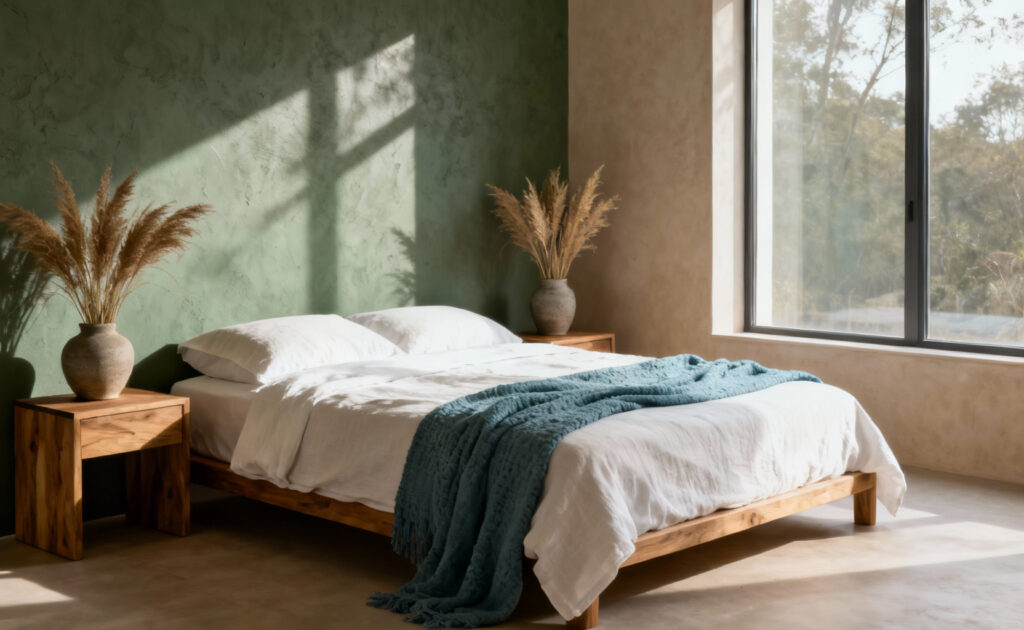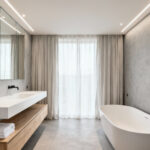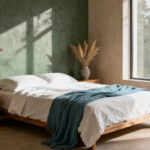While many homeowners invest heavily in premium bedding, they often overlook the profound impact their walls have on rest. This oversight can undermine sleep quality because bedroom wall decor acts as the “sleep architecture” of your sanctuary. Investing in sophisticated wall treatments—from biophilic textures to acoustic panels—is essential for achieving true restoration.
The vertical surfaces of a bedroom dictate the psychological and sensory conditions necessary for deep rest. They guide your nervous system toward calm. Your environment exerts a direct neurological influence on your body’s ability to wind down. Highly saturated colors or chaotic patterns can trigger alertness, while hard, reflective surfaces amplify noise and create distracting glare.
To truly support your circadian rhythm, the room’s shell must prioritize sensory regulation. This means utilizing muted tones, like soft blues and earthy neutrals, to lower your heart rate. It also requires choosing matte finishes to absorb rather than reflect light.
This guide reveals the essential design principles needed to turn your bedroom walls into a component of your wellness routine. We will examine how specific textures, such as upholstered panels or lime plaster, improve acoustics. We will also look at how simplifying visual inputs minimizes mental stimulation. By aligning interior design with wellness architecture, you build a structural foundation for better sleep and long-term health.
Phase 1: Biophilic Foundations (Connecting to Nature)
Establish your bedroom as a sanctuary by treating the walls as the primary canvas for restoration. Begin this transformation by adopting an earthy color palette. Select grounding hues found in nature, such as sage green, muted blues, or warm sandy taupes.
These shades mimic the outdoors and signal the brain to relax, effectively lowering cortisol levels after a high-stimulation day. By enveloping the room in these soothing tones, you create an immediate physiological shift toward calmness as you prepare for sleep.

Once you establish the color foundation, layer in visual and tactile elements to reinforce the biophilic connection. Choose artwork that depicts the natural world, such as oversized botanical prints, landscapes, or abstract pieces featuring organic, biomorphic shapes. If you are defining your overall aesthetic, read our guide on bedroom art aesthetic ideas.
To deepen the sensory experience, introduce natural textures directly onto the walls. Install wood slat panels, hang rattan art, or place a woven tapestry above the bed. These raw materials add warmth and break up flat surfaces, creating a tactile complexity that mirrors the natural environment.
Finally, bring actual life into the vertical space to maximize the room’s wellness potential. Integrate vertical greenery to bridge the gap between the indoors and the outside. Install small floating shelves to display trailing plants like ivy or ferns, which soften architectural lines and improve perceived air quality. You can also curate a “living gallery” by mixing framed pressed flowers with potted greenery. This blend of static art and living flora transforms a standard wall into a dynamic, breathing component of your recovery space.
1. Living Wall Installations: Integrating Air-Purifying Vertical Gardens
Installing a vertical garden transforms your bedroom into a restorative sanctuary. This feature acts as “living art,” utilizing biophilic design principles to reduce stress and create a tranquil focal point essential for relaxation.
Beyond aesthetics, these installations actively improve sleep health by filtering indoor toxins like formaldehyde and benzene. To maximize air purification, combine varied species such as Ivy, Spider Plants, Pothos, and Peace Lilies. A diverse mix of leaf shapes effectively captures a wider range of airborne pollutants, ensuring your sleeping environment remains clean and oxygenated.
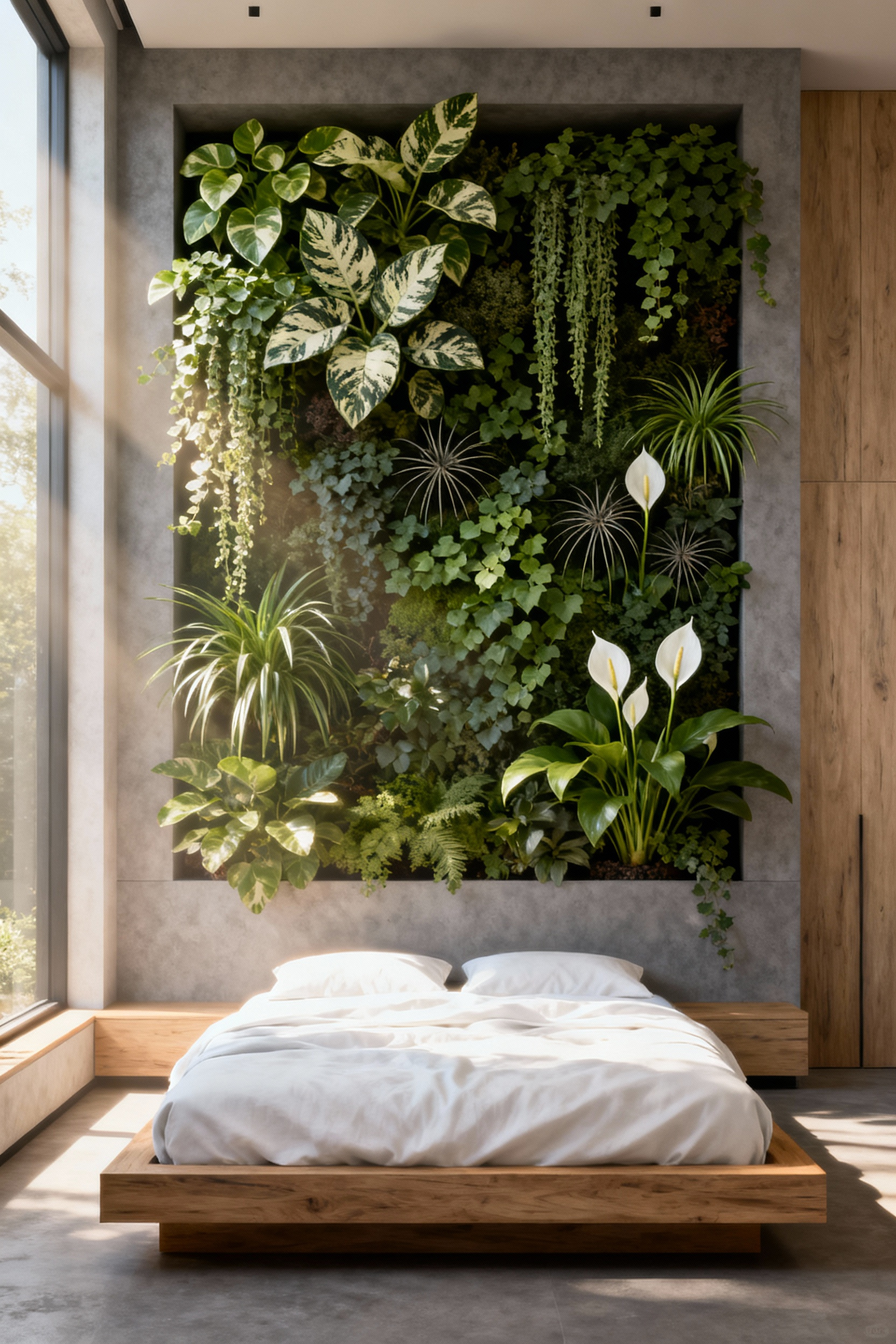
Successful execution requires careful attention to structure and maintenance. Opt for a modular or felt pocket system to maintain a clean, organized look without sacrificing floor space. Since bedrooms often lack sufficient natural light for dense vegetation, integrate LED grow lights to support plant health.
Crucially, protect your existing architecture. Use a lightweight soil mix to reduce wall strain and install a drip or self-watering reservoir system. This approach ensures consistent moisture levels while preventing water damage, offering a low-maintenance solution for a healthier home.
2. Raw Materiality: Unfinished Wood Sculptures for Grounding Energy
Incorporating unfinished wood into your bedroom decor provides immediate physiological benefits beyond simple aesthetics. Research indicates that exposure to natural wood grain and raw textures significantly reduces stress levels and slows the heartbeat.
To maximize this calming effect, select wall sculptures or panels where the surface remains unrefined. Avoid pieces with heavy, glossy sealants, as these create a barrier between you and the material. Instead, prioritize designs with simple wax or oil finishes that preserve the tactile connection to nature and foster a warm, grounding atmosphere.
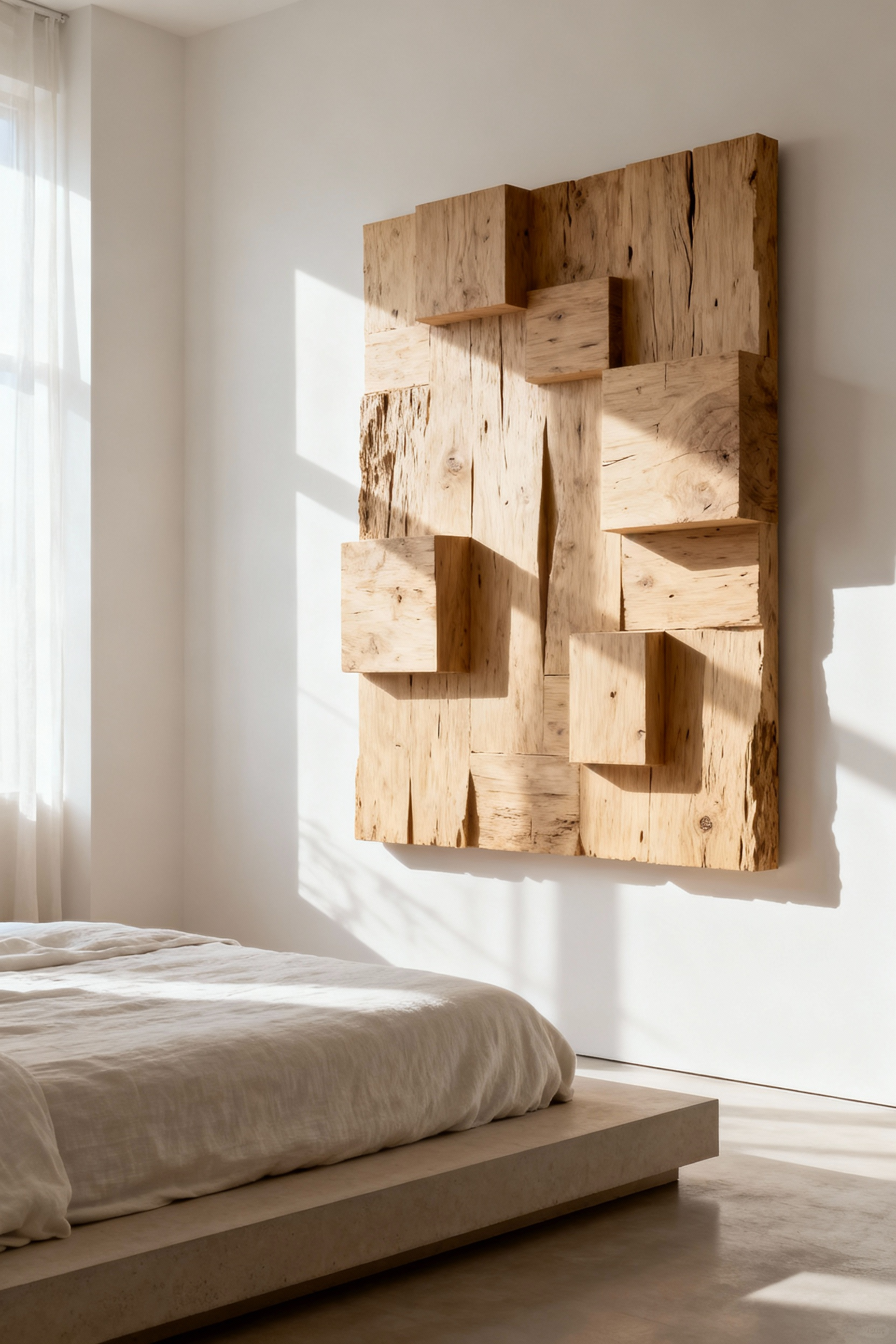
The placement and shape of these wooden elements are critical for anchoring the room’s energy. Install vertical sculptures or planks directly behind the headboard to establish a sense of stability and height. This alignment channels the “Wood Element” from Feng Shui, which promotes vitality and growth while grounding the bed—the room’s most important feature.
When selecting specific pieces, look for organic, fluid forms rather than sharp, angular designs. Sculptures that embrace natural irregularities—such as knots, cracks, or wave-like grain patterns—mimic the rhythms of the natural world and help balance scattered mental energy.
To successfully introduce raw materiality into your sleep sanctuary, follow these guidelines:
- Seek Authenticity: Look for items specifically labeled as driftwood, reclaimed, or salvaged to ensure a genuine earthy presence.
- Embrace Imperfection: Choose hand-carved works where the artist intentionally highlights the wood’s unique flaws.
- Scale Appropriately: If a single large installation is not feasible, create a gallery wall using a grouping of smaller, thick raw wood pieces to achieve a similar therapeutic effect.
3. Large-Scale Nature Photography: Reducing Cortisol Through Visuals
Nature photography does more than beautify the bedroom; it triggers a genuine physiological relaxation response. Research indicates that viewing nature scenes can reduce cortisol levels by up to 13%, effectively signaling the body to unwind.
To achieve this, prioritize imagery that induces “soft fascination.” Look for calm water landscapes, misty forests, or distant mountain vistas. These subjects engage the mind gently without demanding intense focus, which helps lower heart rates and prepares the brain for rest.
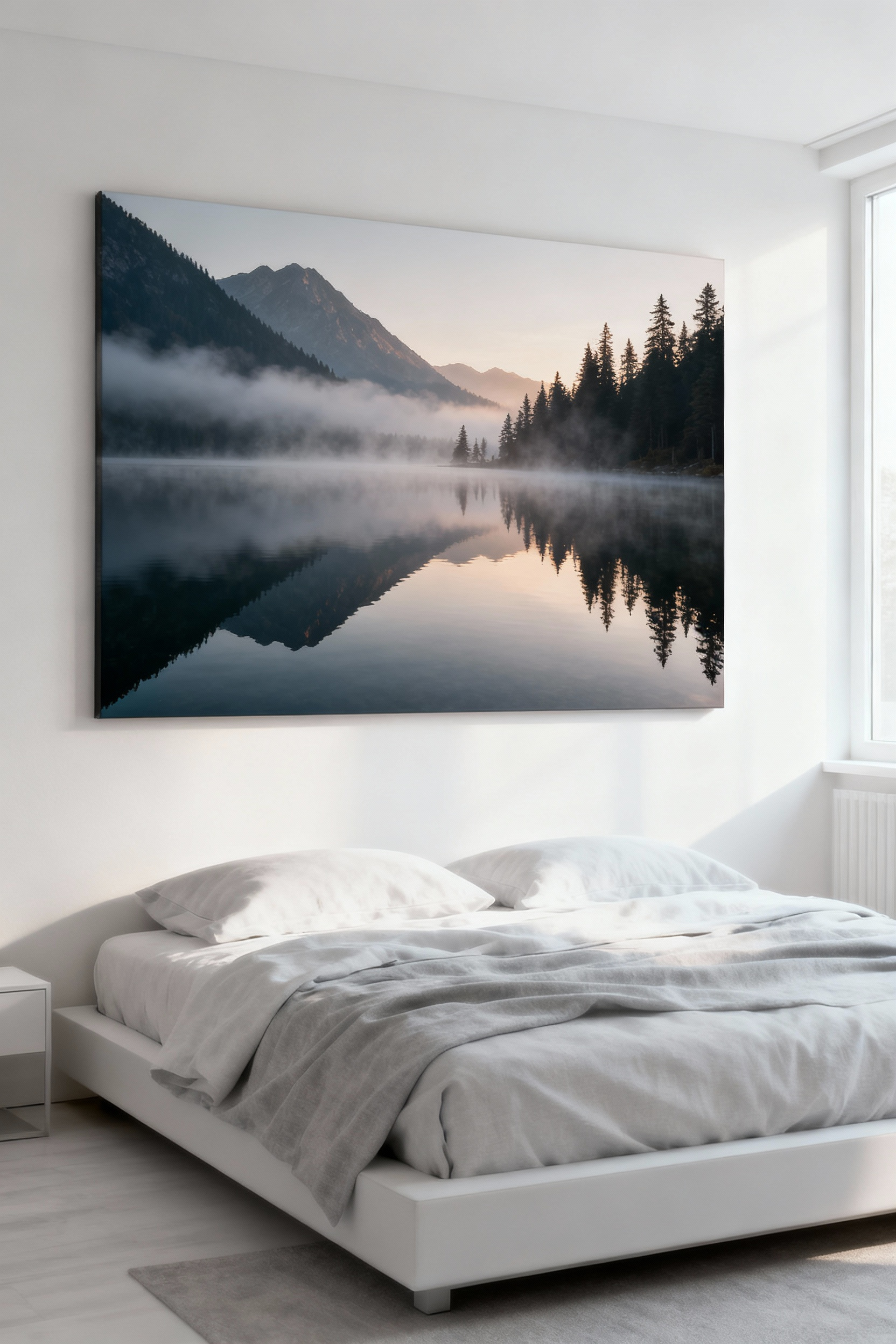
For the most immersive impact, size and placement are critical. Select a large-scale print or a multi-panel set and position it centrally, such as directly above the headboard. This creates an architectural “window” effect that counteracts feelings of confinement often found in smaller rooms. The large format visually transports the viewer, making the restorative benefits of the image more potent than smaller, scattered frames.
Finally, curate the visual content to support a sleep-conducive atmosphere. Adhere to a palette dominated by soft blues, calming greens, and neutral earth tones like beige or grey-green. These colors are inherently soothing and prevent visual overstimulation. Avoid photography with high-energy subjects, such as dynamic cityscapes or intense action shots of wildlife. High-complexity visuals stimulate the senses, while simple, vast scenes facilitate the mental quiet needed for deep sleep.
4. Botanical Presses: Preserving Nature in Non-Toxic Framing
Integrating pressed botanicals into your bedroom decor invites a direct connection to nature, a core principle of biophilic design that supports relaxation and mental restoration. To maintain healthy indoor air quality, prioritize eco-kind materials for these displays.
Choose frames crafted from natural or reclaimed wood and utilize acid-free paper or mat board for backing. This selection process minimizes Volatile Organic Compounds (VOCs), ensuring your decorative choices actively support a non-toxic sleep environment.

Proper preservation relies on precise, low-chemical techniques. Secure your specimens using small dabs of low-toxicity adhesive, such as clear-drying white craft glue or acid-free double-sided tape. Apply these with a toothpick to avoid staining the plant matter or saturating the backing with excess chemicals.
Furthermore, protect the natural colors from degradation by installing UV-protective glass or acrylic sheets. If you use standard glass, position the artwork away from direct sunlight to prevent the organic pigments from fading.
You can elevate the aesthetic by curating a floating gallery wall. Use floating glass frames to sandwich the botanical between transparent panes, or group a series of mismatched wood frames for an organic texture. This arrangement creates a whimsical focal point above a headboard or on an accent wall, highlighting the delicate nature of the greenery while keeping the visual weight of the room light and airy.
Phase 2: Sensory Softening (Acoustics and Texture)
Think of your bedroom as a recovery zone. Controlling the acoustic environment is just as vital as managing light. Hard surfaces like glass, metal, and bare plaster reflect sound, creating subtle auditory stress that disrupts relaxation.
To achieve true sensory softening, prioritize decor that actively dampens noise. Acoustic wood slat panels offer a sophisticated solution for this specific wellness goal. Often backed with felt, these panels absorb echoes and muffle external disturbances while adding visual warmth through natural grain and clean architectural lines.
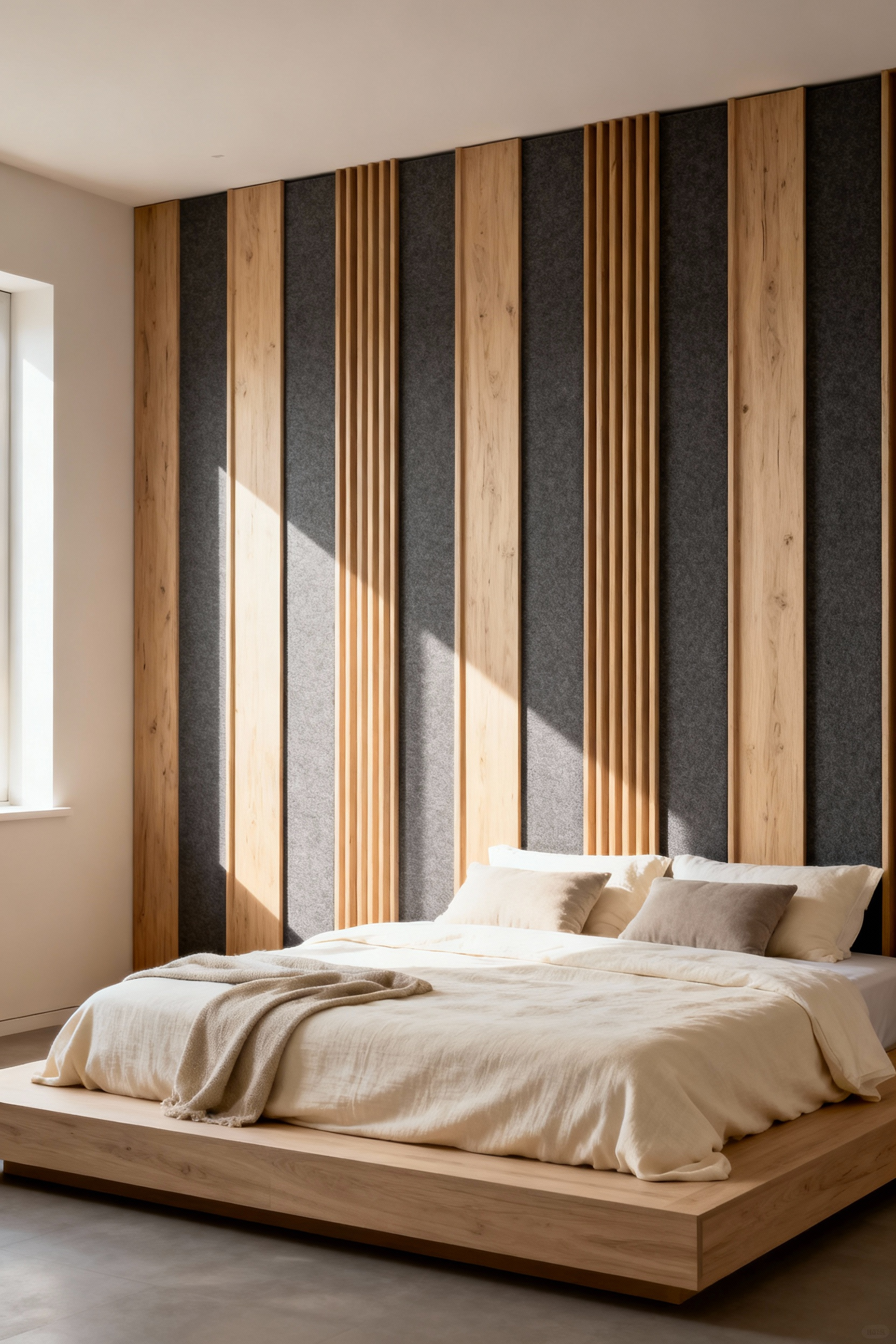
Create a sense of physical safety by extending these textures into a full-wall acoustic headboard. Spanning the entire width of the wall behind your bed maximizes noise reduction and creates a “cocooning” effect that anchors the room.
To further enhance the restorative atmosphere, select wall decor that offers a calming tactile response.
- Layer plush textiles: Incorporate yarn hangings, macrame, or woven tapestries to break up flat surfaces and absorb sound waves.
- Select tactile fabrics: Utilize upholstered panels in velvet, boucle, or chenille to introduce softness that appeals to the touch.
- Apply porous materials: Choose felt art tiles or porous wood finishes instead of highly reflective, glossy frames.
5. The Textile Wall: Hand-Woven Tapestries for Acoustic Dampening
A quiet environment promotes restorative sleep, yet hard surfaces in a bedroom often cause unnecessary reverberation. Hand-woven tapestries offer a stylish solution to this acoustic challenge.
By choosing large, densely woven textiles made from wool or heavy cotton, you actively absorb sound waves rather than reflecting them. This simple addition reduces echo and transforms a stark room into a serene sanctuary capable of supporting deep rest.

Consider positioning the tapestry as a soft, textured alternative to a traditional headboard. Hang the piece directly above the bed, ensuring it extends wider than the mattress frame to ground the space visually. This placement maximizes sound dampening on the primary wall while creating a dramatic focal point. Current design trends favor natural fibers and abstract geometric patterns, allowing you to infuse a modern Japandi or bohemian aesthetic while improving the room’s auditory health.
To achieve the best acoustic performance, prioritize weight and surface area. A thin fabric provides minimal benefit; you need density to effectively capture noise. If you prefer a lighter decorative piece, utilize a professional layering technique for a budget-friendly boost. Mount an inexpensive foam acoustic panel or a thick blanket on the wall, then hang your decorative tapestry over it. This hidden layer significantly increases sound absorption without compromising your design vision.
6. Upholstered Wall Panels: Softening Hard Edges for Psychological Safety
Upholstered wall panels enhance acoustic comfort and reduce visual noise. Hard surfaces in a bedroom often amplify sounds, which keeps the nervous system on high alert. Installing padded panels creates a sound-deadening barrier that absorbs echoes and muffles external distractions. This silence is essential for psychological safety, turning the bedroom into a true sanctuary where the mind can fully decompress.

To create a profound sense of security, consider the current trend of an extended headboard. Design the panels to stretch floor-to-ceiling or wall-to-wall behind the bed. This architectural choice provides an enveloping, “cocooning” effect that visually grounds the sleeping area. It establishes a tangible backdrop of plushness, evoking the restorative atmosphere of a luxury wellness retreat.
When selecting materials, prioritize tactile softness to deepen the feeling of comfort. Fabrics like velvet, linen blends, or soft suede invite touch and add necessary warmth to the space. For smaller rooms, apply specific design strategies to maintain an airy feel:
- Orient panels vertically to draw the eye upward and visually elongate the walls.
- Choose light, tonal fabrics to prevent the feature from feeling heavy or imposing.
7. Macramé and Organic Fiber Art: Adding Tactile Warmth Without Clutter
Introduce texture and depth to your bedroom using macramé or organic fiber art. These pieces cultivate a calm, cozy atmosphere without relying on numerous small objects that contribute to visual clutter.
By selecting sustainable materials like cotton, jute, hemp, or wool, you bring a tactile quality to the room that flat artwork cannot replicate. The intricate knotting and layered depths provide necessary visual interest and warmth, allowing you to bypass bright colors or complex imagery that might overstimulate the senses before sleep.

Maximize this impact by opting for a single, oversized focal point above the headboard. This approach creates dramatic texture and serves as a soft, unique alternative to a traditional headboard or a chaotic gallery wall. Adhere to a neutral, earthy palette featuring natural ivory, beige, sand, or muted terracotta. These subdued tones ensure the wall decor feels serene rather than distracting, which helps maintain a tranquil environment essential for mental wellbeing.
Consider the specific dimensions of your room to further enhance the sense of space. For smaller bedrooms, select a tall, narrow vertical design to draw the eye upward. This technique creates an illusion of height and combats the psychological stress often associated with cramped or low-ceilinged environments. By focusing on texture over pattern and scale over quantity, you add sophistication to the space while keeping the overall aesthetic clean and restorative.
8. Velvet Fluting: Vertical Lines for Height and Hush
Velvet fluting introduces a layer of sophisticated architecture to your bedroom while manipulating the perception of space. The strong vertical channels act as visual guides, drawing the eye upward to create an illusion of greater ceiling height. This verticality makes even compact rooms feel more expansive and airy.
Beyond its structural benefit, the material itself adds rich dimension. The interplay of light and shadow within the velvet grooves transforms a static wall into a dynamic, tactile surface that deepens the room’s aesthetic character.

From a wellness perspective, this design choice offers significant acoustic benefits. Hard surfaces bounce sound, creating low-level echoes that disturb rest, but the plush composition of upholstered velvet absorbs ambient noise. This sound-dampening quality fosters a “hushed” atmosphere essential for deep sleep.
To maximize this effect, install the fluting from floor to ceiling behind your bed. This arrangement functions as an ultra-glamorous, oversized headboard, anchoring your sleeping area and creating a protective, intimate “cocoon” that separates your rest zone from the rest of the home.
Phase 3: The Psychology of Space (Feng Shui and Flow)
Your bedroom wall decor directly influences your psychological state and the flow of *Qi*, or energy. To cultivate a restorative atmosphere, prioritize visual inputs that signal safety to the brain.
Select artwork that evokes peace, such as gentle landscapes or soothing abstract pieces with flowing curves. If you value relationship stability, incorporate images of items in pairs. Conversely, remove pieces depicting chaos, sadness, or sharp lines, as these generate negative psychological tension.
Pair this imagery with wall colors in earthy neutrals, soft pastels, or muted blues. These shades reduce physiological arousal and create the nurturing environment necessary for restful sleep.
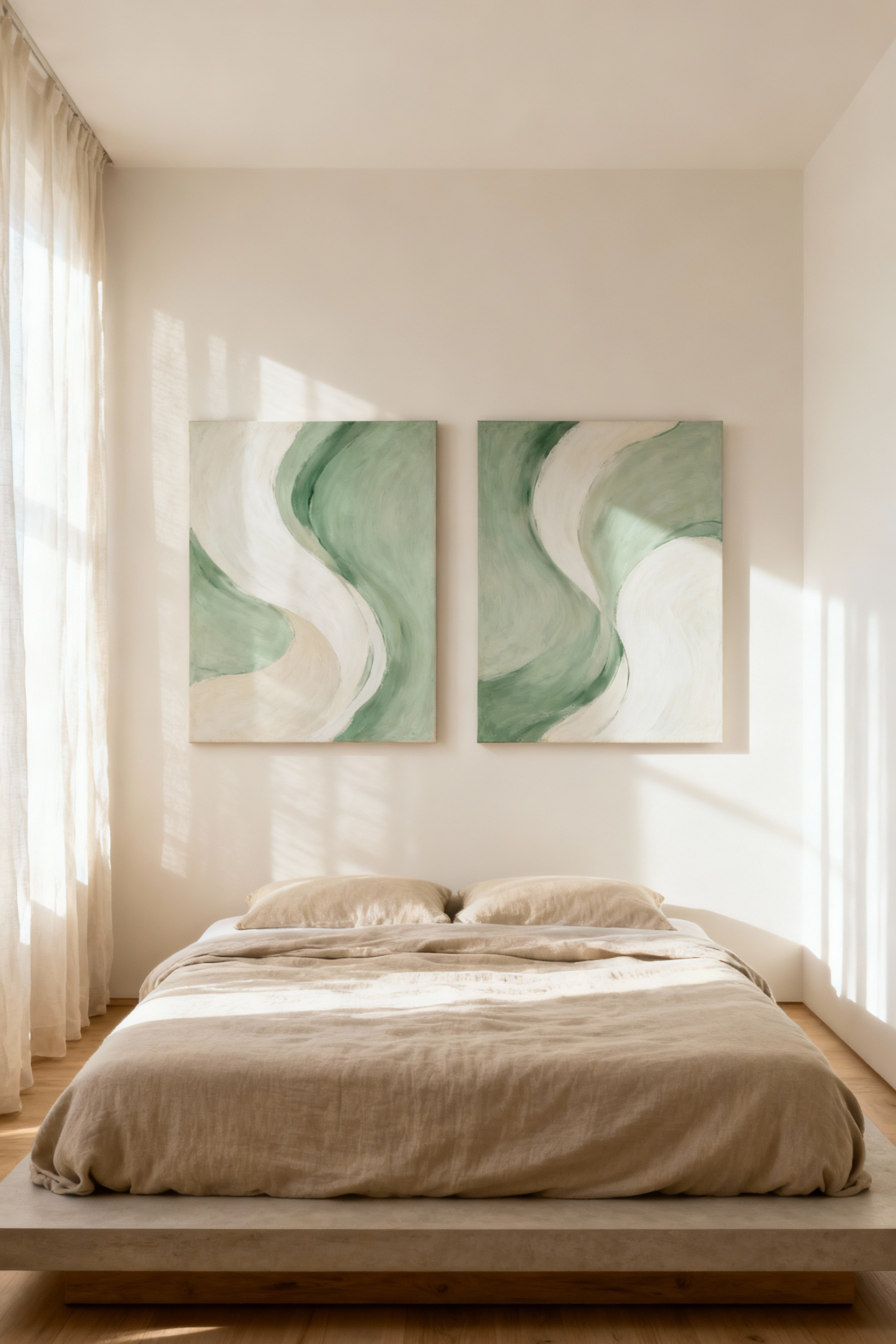
The physical placement of your decor also plays a critical role in how you experience the space. Treat the wall behind your headboard as a foundation for security. Install a single, substantial art piece or a symmetrical arrangement here to symbolize solid support.
Avoid hanging heavy, imposing objects or images of gushing waterfalls directly over the bed, as these can subconsciously induce feelings of pressure or instability. Finally, evaluate your use of mirrors. Remove any reflective surfaces positioned to face the bed. In Feng Shui, a mirror reflecting the sleeper invites restless energy and symbolically doubles worries, disrupting the tranquility required for deep rejuvenation.
9. The Command Position: Anchoring Art Above the Bed
The “Command Position” relies on a solid wall behind your bed to provide psychological support and security. When you select art for this space, prioritize pieces that reinforce a sense of safety rather than anxiety.
Avoid hanging heavy, sharp, or precarious objects, such as large mirrors or heavy glass frames, directly overhead. These items can subconsciously alert the brain to potential danger, disrupting sleep. Instead, choose lightweight canvases, soft textiles, or securely mounted wall hangings that foster a peaceful, protected environment.
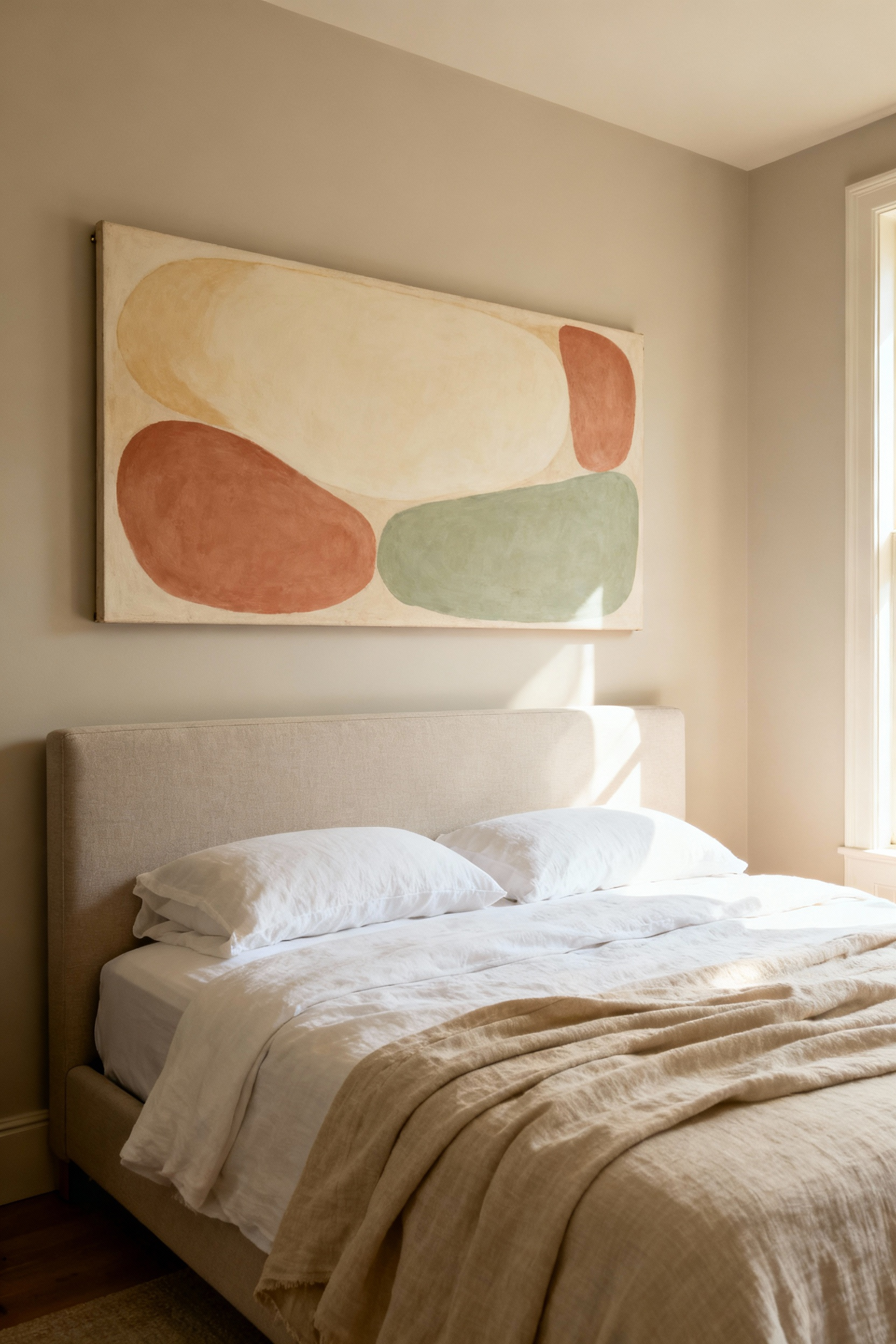
Visual harmony is essential for anchoring the bed as the room’s focal point. Select artwork with a width spanning approximately two-thirds to three-quarters of your headboard or bed frame. This ratio ensures the decor feels proportional and creates a cohesive unit with the furniture.
Furthermore, opt for a horizontal or landscape orientation rather than a vertical one. While vertical lines stimulate active energy, horizontal lines promote a grounding, restful atmosphere that aligns with the restorative function of a bedroom.
Proper placement finalizes this visual connection. Hang the bottom of the artwork six to 12 inches above the top of the headboard. This proximity bridges the gap between the furniture and the art, preventing the piece from looking disconnected or “floating” on the wall. By keeping the artwork visually tied to the bed, you maintain the solid, supportive stability required for the Command Position.
10. Symmetrical Sconces: Balancing Relationships and Energy Flow
Install identical sconces on either side of the bed to establish immediate visual harmony. This mirrored placement roots the room in stability. In the principles of wellness architecture and Feng Shui, symmetry reinforces the energy of partnership and equality. It visually signals that both individuals in the space hold equal weight, which fosters a balanced and supportive dynamic within the relationship.
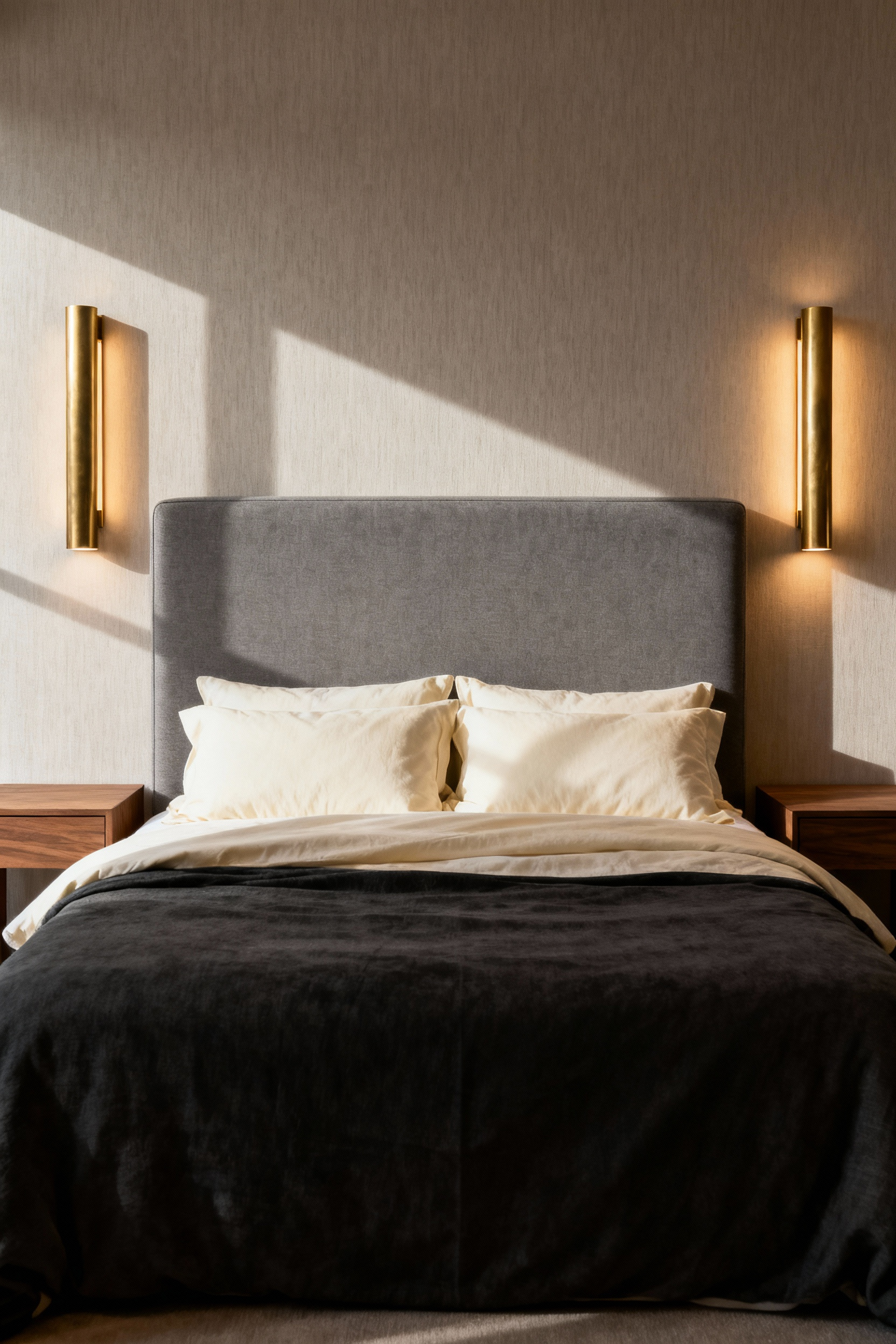
Wall-mounted fixtures also serve a crucial functional role by freeing up valuable surface area on your bedside tables. This reduction of physical clutter directly improves the room’s energy flow. An uncluttered nightstand prevents stagnant energy, known as “Sha Chi,” from accumulating near your head while you sleep. By opening up this horizontal space, you promote a smooth circulation of positive *Chi*, creating a tranquil environment essential for deep rest. To find more high-impact upgrades, review these modern bedroom decor pieces for a truly chic look.
To fully support restorative sleep and intimacy, you must prioritize the quality of the light itself. Select sconces with dimmable features and use bulbs that emit a warm glow, ideally below 3000 Kelvin. Harsh or cool lighting disrupts the body’s natural rhythms and alerts the brain. Instead, a soft light diffused through a shade creates a cozy atmosphere conducive to relaxation. This adjustable ambiance allows you to transition seamlessly from evening reading to sleep.
11. Circular Mirrors: Softening Chi Flow (and When to Cover Them)
Circular mirrors introduce organic curves to a space often dominated by straight lines. Standard bedroom furniture, such as wardrobes and dressers, creates sharp angles that can generate visual tension.
A round or oval shape softens this effect by encouraging a gentle, continuous flow of energy, or Chi. By breaking up the monotony of rectangular forms, you create a softer, more tranquil environment that supports mental relaxation.
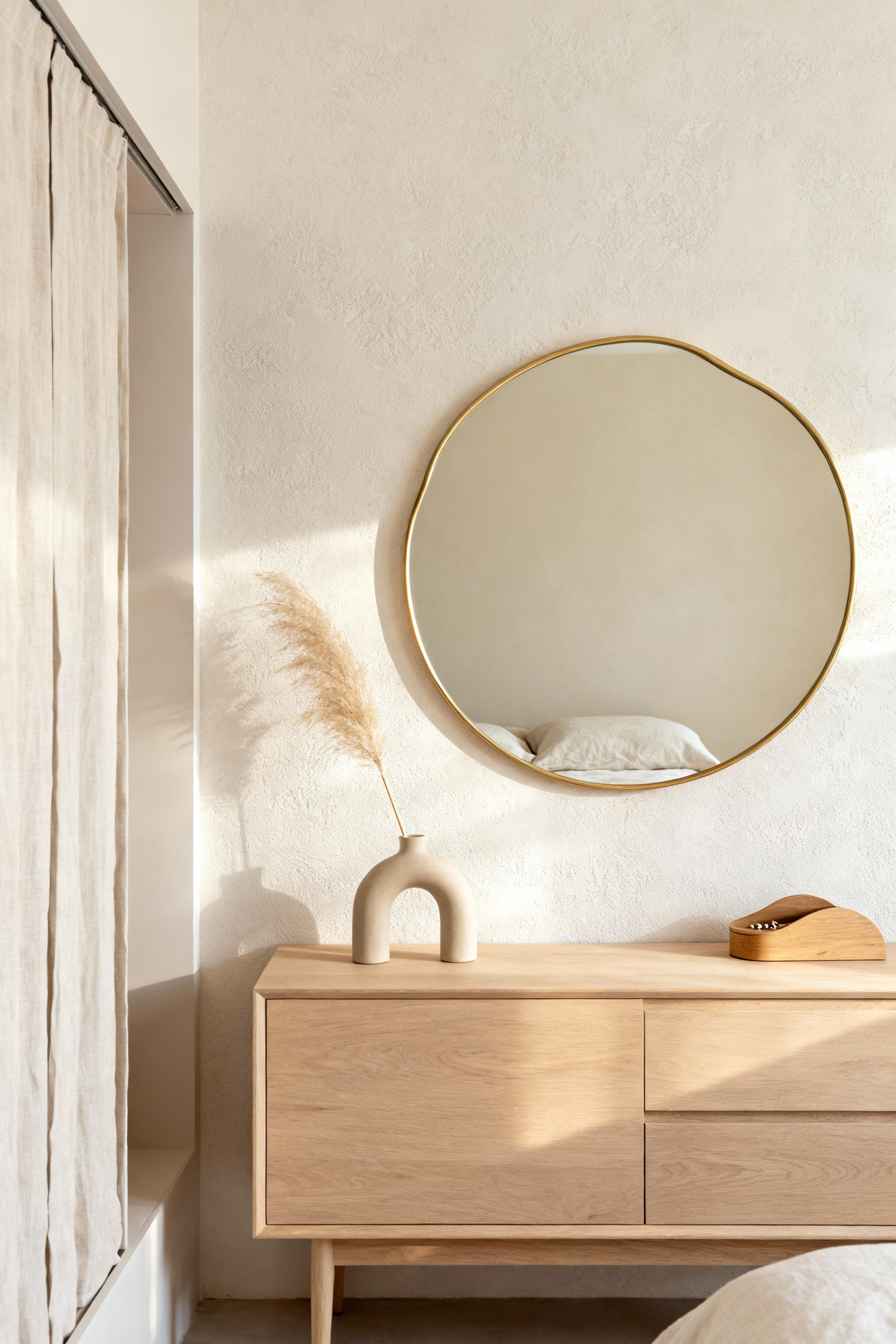
Strategic placement maximizes both the aesthetic and energetic benefits of these mirrors. Consider positioning a large circular mirror above a console table or dresser to establish a modern, elegant focal point. When selecting the location, ensure the glass reflects something pleasant, such as natural light from a window or a calming piece of artwork. Mirrors symbolically “double” the energy of whatever they reflect, so you must avoid angles that capture clutter, messy corners, or the bedroom door.
While mirrors add light and depth, they also activate energy, which can prove problematic for sleep hygiene. The most critical rule is to avoid placing a mirror where it reflects the bed while you sleep. A mirror facing the bed bounces energy around the room, often resulting in restlessness and disrupted sleep patterns. If your room layout forces the mirror to face the bed, simply cover it with a beautiful fabric or screen each night to dampen the energy and protect your rest.
12. Low-Contrast Galleries: Reducing Visual Noise Before Sleep
Your bedroom walls should signal your brain to disengage, not stimulate it with excess data. High-contrast imagery and chaotic arrangements create visual noise that keeps the mind alert when it needs to wind down.
To counter this, curate a gallery specifically designed for rest. Select artwork with muted, monochromatic palettes, such as black-and-white photography, sepia tones, or subtle pastels. Prioritize calm subjects like minimalist line drawings or soft-focus nature scenes. These simple themes require less cognitive processing, allowing your eyes to glide over them without triggering active engagement.

Structure matters as much as the imagery itself. Enforce a symmetrical grid layout, such as a 2×3 or 3×3 arrangement with consistent spacing between items. This strict symmetry creates a visual rhythm and predictability that feels safe to the subconscious. To further unify the display, use identical frames and consistent white matting for every piece. Whether you choose thin black, white, or light wood frames, this uniformity transforms multiple images into a single, quiet design element, effectively eliminating visual clutter.
For a deeper physiological impact, consider the relationship between your art and the wall color. A contemporary wellness strategy involves hanging low-contrast galleries on a deeply saturated, dark wall, such as navy, charcoal, or forest green. Dark surfaces absorb surrounding light rather than reflecting it. This allows pale art and light frames to stand out quietly without the harsh vibration often found against bright white walls. If you are considering a full surface change, refer to our essential tips for the perfect bedroom wallpaper accent wall. This specific combination reduces glare and lowers the room’s overall energy, creating the ideal conditions for restorative sleep.
13. Intention-Based Curation: Removing Subconscious Stress Triggers
Your bedroom walls should act as a filter for the outside world, not a reflection of its chaos. Every visual element carries a cognitive load, meaning your brain processes shapes and colors even when you are not actively focusing on them. Jagged lines, complex geometric patterns, and chaotic abstracts can subtly spike cortisol levels, preventing the nervous system from shifting into a rest state.
To counter this, practice intention-based curation by applying the “non-trigger” test to every piece of art. Ask yourself if the image evokes immediate peace or if it reminds you of a demanding environment, such as a bustling city or a high-intensity workspace. Even if you love a piece aesthetically, if it depicts a stressful narrative, it belongs outside the bedroom. Prioritize nature scenes like tranquil forests or gentle abstracts, as these visuals lower anxiety and signal safety to your subconscious.
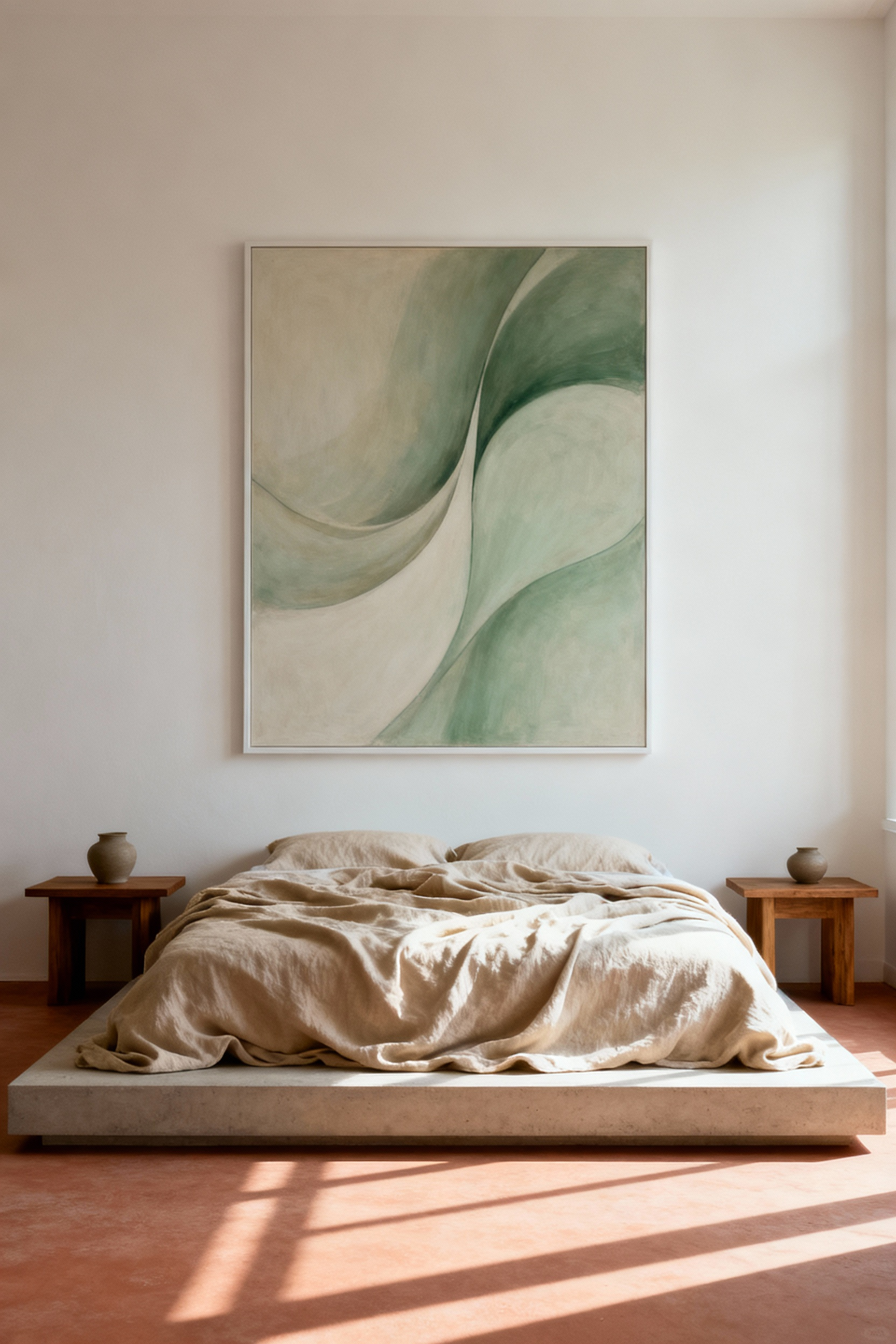
The physical qualities of your decor play an equally critical role in regulating your body’s stress response. Strictly prioritize cool and neutral tones—such as soft blues, muted greens, and pale lavenders—as these wavelengths are scientifically proven to reduce tension. Actively reject high-energy colors like bright reds or oranges, which stimulate the brain rather than soothe it.
Furthermore, consider the texture and finish of your wall treatments. High-gloss surfaces reflect light in sharp, attention-grabbing ways that create visual “noise.” Select matte or eggshell finishes to diffuse light softly, ensuring your sanctuary remains a low-stimulus environment conducive to restorative sleep.
Phase 4: Advanced Wellness Integration (Light and Atmosphere)
True wellness design begins with synchronizing your environment to your body’s internal clock. Replace standard wall fixtures with color-tunable white (CTW) smart LEDs to mirror the natural solar cycle. Program these fixtures to emit a cool, energizing light between 4000K and 5000K in the morning, transitioning to a warm, dim glow below 2700K in the evening.
For a seamless effect, install smart LED strips behind a headboard or within decorative wall panels. As night falls, shift your focus to low-intensity accent lighting, such as picture lights or low-mounted sconces. This strategy creates a “sunset-like” ambiance that signals your body to relax without suppressing melatonin production.
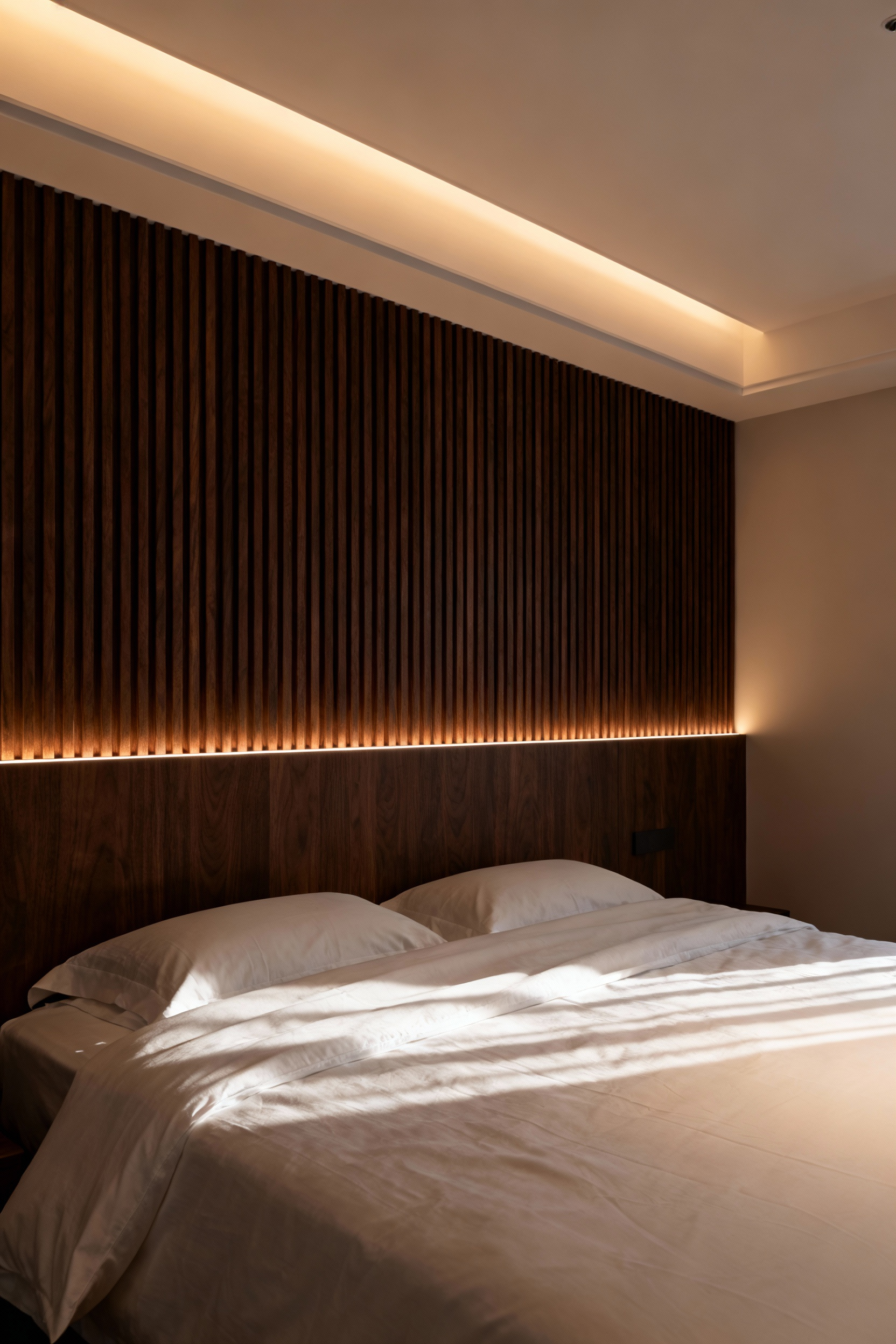
Beyond artificial illumination, your physical wall finishes must support respiratory health and psychological grounding. Maximize natural light exposure by strategically placing large mirrors opposite windows and applying a light-reflective paint palette of soft whites or pale greens.
However, you must select these finishes carefully; prioritize low- or zero-VOC paints to maintain pure indoor air quality. Complement this by sourcing wall decor made from natural, non-synthetic materials like wood panels, stone, or woven fibers. These biophilic elements minimize indoor toxins and visually reinforce a calming connection to nature.
14. Circadian Sconces: Wall Lighting That Mimics Sunset Spectrums
Support your sleep hygiene by integrating circadian lighting directly into your wall decor. Set your sconces to an automated schedule using smart controls to mimic a natural sunset.
Ideally, program the light to shift toward a low-intensity, amber or golden spectrum 60 to 90 minutes before bedtime. This visual cue signals your brain to release melatonin, preparing your body for restorative rest rather than stimulating it with harsh blue frequencies found in standard bulbs.
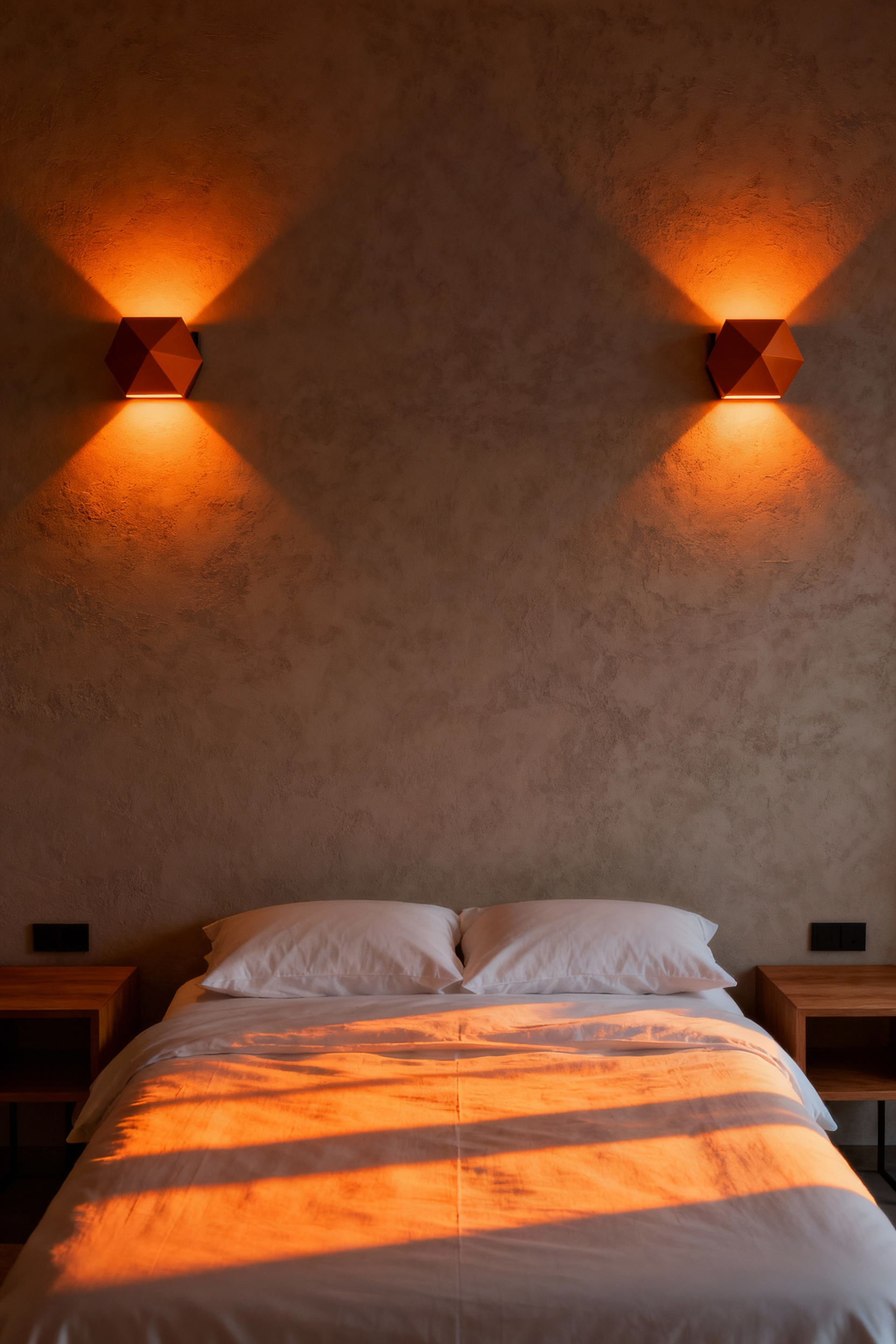
Beyond biological benefits, wall-mounted sconces offer significant spatial advantages. Install them symmetrically on either side of the bed as a streamlined alternative to traditional table lamps. This placement maximizes valuable nightstand surface area and reduces visual clutter, fostering a more organized and peaceful environment. It provides focused, adjustable illumination for reading without occupying physical space, keeping the bedroom airy and open.
Select fixtures that naturally enhance the warm-glow spectrum of the sunset setting. Natural materials like wood, rattan, or linen shades pair beautifully with this soft lighting, as do warm metallic finishes such as brass or copper. These elements complement design styles focused on comfort, including Scandinavian, Rustic, or Bohemian aesthetics. By coordinating the light temperature with tactile materials, you create an intimate retreat that supports both your interior design goals and your physical wellbeing.
15. Kinetic Wall Sculptures: Promoting Meditative States Through Gentle Movement
Kinetic wall sculptures serve as powerful tools for mental restoration in the bedroom. By selecting pieces crafted from natural woods like walnut or birch, you connect your space to organic design principles. This enhances a calm, minimalist aesthetic.
Functionally, these sculptures act as “open-eyed meditation anchors.” The slow, rhythmic motion of patterns like ripples or infinity loops captures your gaze. This gentle visual focus quiets mental clutter and prepares the mind for deep rest.

Choose non-motorized, wind-up mechanisms, often called automata, to maintain a tranquil atmosphere. These wooden models offer a deliberate, continuous run-time of up to an hour with no cords or batteries. This absence of electrical hum and artificial light is essential for a sleep-conducive environment. The self-contained movement provides a grounding contrast to the high-speed digital world.
Strategic placement determines the success of this wellness feature. Install the artwork in a designated quiet zone, such as a wall facing a reading chair, rather than directly above the bed. While these sculptures are quiet, mechanical movement naturally produces a soft, low-level sound. Mounting the piece away from your sleeping position ensures the rhythm induces a meditative state without disturbing light sleepers.
16. Chromotherapy Accents: Using Art to Influence Heart Rate Variability
Chromotherapy accents in bedroom wall decor leverage the psychological impact of color to positively influence Heart Rate Variability (HRV), a critical marker of autonomic nervous system balance.
To optimize your space for sleep, focus on art dominated by soft blues and greens. These cool tones are scientifically linked to a decrease in heart rate and stress levels, promoting the parasympathetic “rest-and-digest” activity necessary for deep relaxation. Conversely, you should restrict warm colors like red or orange to minimal, non-dominant accents. These hues act as energy amplifiers that stimulate the sympathetic nervous system and increase arousal, which disrupts the physiological wind-down process.

The intensity of the color palette is just as important as the hue itself. Opt for artwork with low-chroma, muted, or pale colors rather than vivid, high-saturation tones. Highly vibrant visuals can signal alertness to the brain, working against your goal of tranquility.
To maximize the chromotherapy effect, pair these soft color palettes with calming subject matter. Pieces featuring tranquil nature scenes, particularly water landscapes or quiet abstracts, reinforce the biological signal to slow down, helping you achieve the relaxed state required for restorative sleep.
17. The ‘Empty’ Space: The Japanese Concept of Ma for Mental Clarity
In Japanese culture, the concept of *Ma* (間) defines space not as nothingness, but as an intentional pause that creates rhythm and balance. In wellness architecture, we view this negative space as a critical functional element within the bedroom.
By deliberately leaving significant portions of your walls bare, you reduce visual noise and cognitive load. This absence of clutter allows your eyes and mind to rest, fostering the sense of openness necessary for mental clarity and deep restoration.
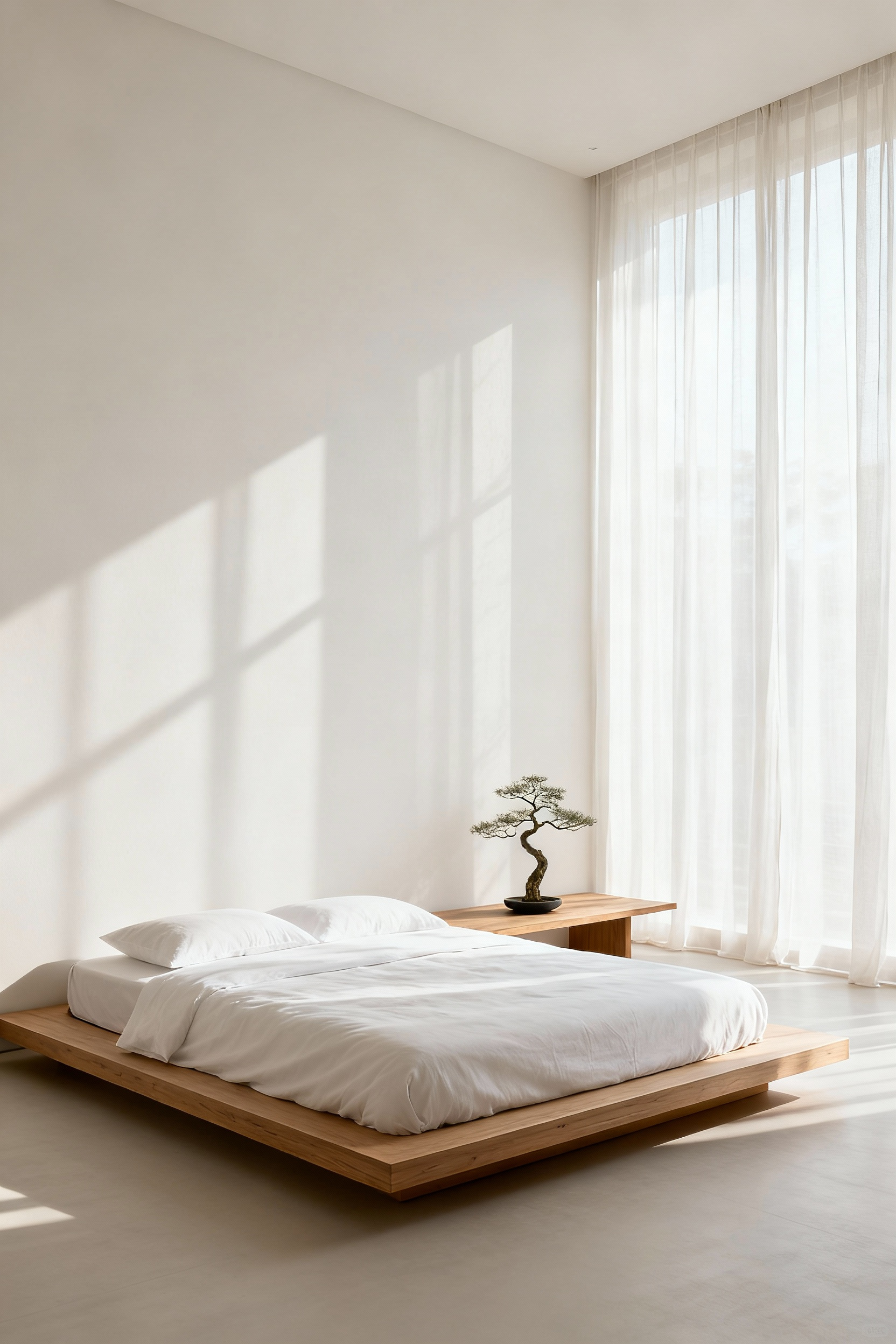
Apply this concept by prioritizing quality over quantity in your decor. Instead of crowding a wall with a multi-piece gallery, choose a single, meaningful artwork. The surrounding empty space magnifies the piece’s impact and prevents the visual overstimulation that often disrupts relaxation.
Complement this minimal approach with matte paint finishes in soft, low-saturation colors. Unlike high-gloss surfaces, matte finishes diffuse light and reduce glare, significantly lowering sensory input to create a more calming visual experience.
Finally, view your walls as a canvas for natural elements rather than storage. Position lighting to create subtle patterns of light and shadow on empty surfaces, transforming the wall into a dynamic, non-static art piece that encourages mindfulness. Avoid mounting heavy shelving or general storage units that crowd the room. If a shelf is necessary, limit it to a few essential objects. This balance between filled and empty space prioritizes substance over excess, directly supporting a calm and focused state of mind.
Conclusion: From Decoration to Restoration – Curating Your Sleep Sanctuary
Transforming your bedroom wall decor requires shifting focus from simple aesthetics to choices that actively support your biology. When you integrate soft, cool tones with organic textures and nature-inspired imagery, you create an environment that invites your nervous system to decompress.
A clutter-free, curated space acts as a physical signal to your brain that the day’s demands have ended. This intentional reduction of visual noise prevents cognitive overload, allowing true restoration to take root the moment you step inside. If you are focused on designing an enduring and timeless space, explore these cozy bedroom decorations.
Adopting this restorative approach turns your home into a vital component of your long-term wellness strategy. As you refine your sanctuary, you prioritize mental clarity and physical vitality over mere decoration. Begin by auditing your current wall decor this evening; remove any items that evoke high energy or stress, leaving only the pieces that anchor you in calm. By curating for peace, you ultimately invest in the quality of your waking life.
